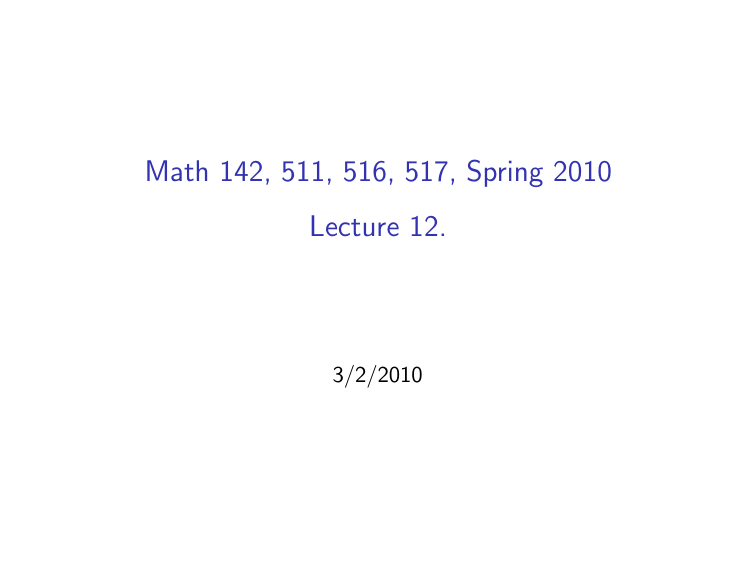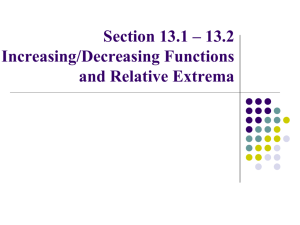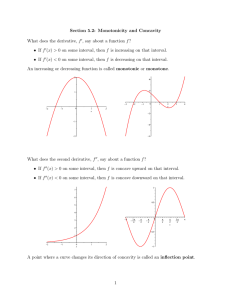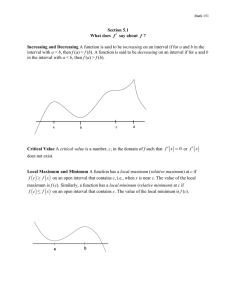Math 142, 511, 516, 517, Spring 2010 Lecture 12. 3/2/2010
advertisement

Math 142, 511, 516, 517, Spring 2010 Lecture 12. 3/2/2010 Homework #16 (Section 4-7) is due Thursday, March 4, 11:55 PM. The due date for the Homework #17 (Section 5-1) and the Homework #18 (Section 5-2) is moved to Monday, March 8, 11:55 PM. Quiz 6 will be held on Thursday, March 4. It will cover Sections 4-7 and 5-1. Section 5-1. First derivative and graphs. Definition. The values of x in the domain of f where f ′ (x) = 0 or where f ′ (x) does not exist are called the critical values of f . Definition. The function f is increasing on an interval (a, b) if f (x2 ) > f (x1 ) whenever a < x1 < x2 < b, and f is decreasing on (a, b) if f (x2 ) < f (x1 ) whenever a < x1 < x2 < b. Increasing / decreasing test (a) If f ′ (x) > 0 on an interval, then f is increasing on that interval (b) If f ′ (x) < 0 on an interval, then f is decreasing on that interval To find intervals on which a function is increasing or decreasing, we will construct a sign chart for f ′ (x) to determine which values of x make f ′ (x) > 0 and which values make f ′ (x) < 0. Definition. A function f has a local maximum at c if f (c) ≥ f (x) when x is near c. Similarly, f has a local minimum at c if f (c) ≤ f (x) when x is near c. The quantity f (c) is called a local extremum if it either a local maximum or a local minimum. Example 1. Given the graph of the function f . (a) What are the x-coordinate(s) of the points where f ′ (x) does not exist? (b) Identify intervals on which f (x) is increasing. Is decreasing. (c) Identify the x coordinates of the points where f (x) has a local maximum. A local minimum. Fermat’s theorem If f has a local maximum or minimum at c, and if f ′ (c) exists, then f ′ (c) = 0 The first derivative test Suppose that c is a critical number of a continuous function f . (a) If f ′ changes from positive to negative at c, then f has a local max at c. (b) If f ′ changes from negative to positive at c, then f has a local min at c. (c) If f ′ does not change sign at c, then f has a no local max or min at c. Example 2. Find the critical values of f , the intervals on which f is increasing, the intervals on which f is decreasing, and the local extrema for p 3 f (x) = 2 x 2 − 4 Do not graph. Example 3. Given the graph of f ′ (x). (a) Identify intervals on which f is increasing. Is decreasing. (b) Identify the x coordinates of the points where f has a local maximum. A local minimum. Section 5-2. Second derivative and graphs. Definition. The graph of the function f is concave upward (CU) on the interval (a, b) if f ′ (x) is increasing on (a, b) and is concave downward (CD) on the interval (a, b) if f ′ (x) is decreasing on (a, b) Definition. For y = f (x), the second derivative of f , provided that it exists, is d ′ f (x) f ′′ (x) = dx Other notation for f ′′ (x) are d 2y dx 2 y ′′ Example 4. Find f ′′ for (a) f (x) = −6x −2 + 12x −3 , (b) f (x) = xe x , √ (c) f (x) = 2 3 x 2 − 4. Definition. An inflection point is a point on the graph of the function where the concavity changes. Example 5. Given the graph of f ′ (x). (a) Identify intervals on which f is concave upward. Concave downward. (b) Find the x-coordinates of inflection points. Concavity test (a) If f ′′ (x) > 0 on an interval, then f is CU on this interval. (b) If f ′′ (x) < 0 on an interval, then f is CD on this interval. The second derivative test Suppose f ′′ is continuous near c. (a) If f ′ (c) = 0 and f ′′ (c) > 0, then f has a local min at c. (b) If f ′ (c) = 0 and f ′′ (c) < 0, then f has a local max at c. If y = f (x) is continuous on (a, b) and has an inflection point at x = c, then either f ′′ (c) = 0 or f ′′ (c) does not exist. Example 5. Find inflection points and the intervals of which the graph of f (x) = x 4 − 2x 3 − 36x + 12 is CU.




